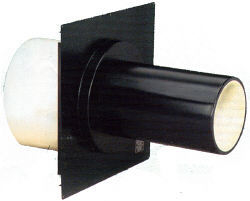When you are installing a wood stove in your home you will want to be sure to
choose the correct size wood stove and
know wood stove safety installation.
When connection your woodstove to your chimney you will need to know that there are four main methods to do this:
- Direct connection to a masonry chimney.
- Passage through a flammable partition into a masonry chimney.
- Entry into a fireplace and chimney.
- Outlet through a wall or ceiling through a factory built metal chimney.
Direction Connection to a Masonry Chimney:
When connection directly into a masonry chimney you will want to be sure that the
stovepipe that is inserted penetrates to the inside edge of the masonry liner, however, it should go NO further than that. It will then need to be sealed with masonry cement. If you use a masonry thimble that is set into the chimney to accept a slip in section of pipe then the masonry cement will not be needed. Keep in mind that if you cannot easily gain access to this connector for cleaning, you will need to use a masonry thimble so you will be able to remove the pipe for periodic cleanings.
Passage Through a Flammable Partition into a Masonry Chimney:
The second connection method, passage through a flammable partition into a masonry chimney, covers any connector which passes within 18 inches of a flammable partition.
NFPA regulation #211 specifies that in these cases the wood stove installation should include either a vented metal thimble which has a diameter 12 inches larger than the stovepipe or that a masonry thimble be ringed by at least 8 inches of fireproof brickwork. According to Mother Earth News the only other prudent option would be to leave a minimum of 18 inches of space around the outside of the stovepipe and then close your hole with a flame-resistant barrier.
Entry into a Fireplace and Chimney:
If connecting your wood stove to the flue above the fireplace then you must plug your chimney below the point of connection. If you are exhausting through the fireplace then the entry to the fireplace must be sealed. Doing this helps to prevent burning embers from falling down into your fireplace and possibly onto the floor (which is a big fire hazard) but it also helps to maintain the proper draft for your wood stove. It is best if chimney entrances for wood stoves are above the fireplace, however some considerations will require that the connection be made through the sealing partition and into the actual fireplace. In any chimney, but especially a fireplace with a cooler external chimney you should extend the stovepipe so that it turns up and into the chimney to help prevent heavy creosoting. (Read more about
Creosote and Flue Fires).
Outlet Through a Wall or Chimney with a Factory Built Metal Chimney:
Passage of stovepipe through any floor, ceiling, or fire wall is prohibited by
NFPA regulations. However, you may pass the stovepipe through a wall, floor, or ceiling if you use a factory-built insulated chimney. If you do not have a suitable masonry chimney then this type of piping is the only option you have.
If you have any concerns about installing and connecting your wood stove speak with your local building inspector to get advice, knowledge about local building codes and possible a recommendation on someone who can do the job for you safely and effectively.
 |
| Insulated Thimble |
Check back for future Woodstove Safety information including:
Woodstove Safety: Choosing and Installing
How to Prevent a Flue Fire


Got a lot of good info from this page! All the best to your blog!
ReplyDeleteChimney Sweep Portland
http://www.rooftopchimneyandroofservices.com